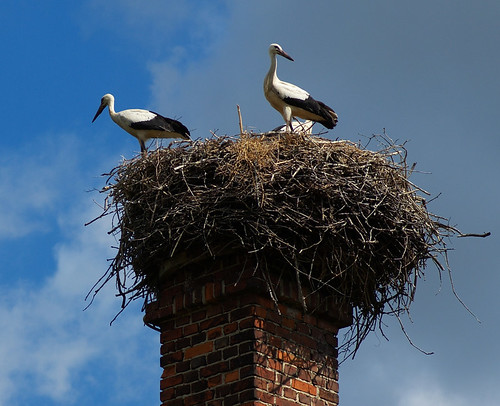Poland’s rich wildlife! Posted by Kasia on Jun 30, 2014 in Uncategorized
Poland is a country rich with wildlife, where the vast stretches of wild lands, from the mountains to the lakes, and well-preserved forests, are home to a fascinating array of species, both rare and common. From the imposing, mud clad, wódka inspiring Żubr (European Bison), to the long-legged white bocian stalk (white stalk), and the dwindling, endangered but elegant forest wilk (wild wolf), the animal inhabitants of this nation are as varied as they are interesting, and as culturally symbolic as they are wild.
So what are some of the iconic Polish animal species?
Wilk – Wolf
Poland has been pooled among the few countries left with the correct environment to support populations of wild forest wolves. In 1998 the wilk became a protected species, and since 2001, when scientifically controlled population studies began, the distribution of wolves across Poland has found to be dauntingly sparse. Most reside in the protect forest areas in the East, where the large nature reserves provide enough room to accommodate the requirements of roaming wolf packs. That said, it is thought that with the growth of protected forest areas in Western Poland, packs are begging to resettle where previous industry had forced them out. It is estimated that around 800 wolves currently reside in Poland, most in the forested hills of the Carpathian Mountains (Karpaty).
Żubr – Bison
From herbal infused vodka (żubrówka), to light and refreshing Polish beer, the European bison has become herald to some of Poland’s most famous beverages. Sadly the species went entirely extinct in the wild from human interference, but has since been reintroduced to its natural habitat in Poland from captivity. Elegant and formidable in equal measure, the żubr now resides in the thick forested areas of the Puszcza Białowieska (Białowieża Forest). The animal is characterised by a rough fur coating with a large shoulder bulge and stern, short legs; they’re quick and tough, and not to be played with!
Bocian – Stork
In Poland it is believed that a white stork nesting on a household signifies good luck and prosperity to those who live inside. So it’s no wonder that the bocian is one of the nation’s most favourite of indigenous animals. Poland boasts the largest nesting population of white stalks, so many in fact that it’s said almost one in four of the world’s white stalks are a Polish bocian.
Dzik – Wild boar
In Poland wild boars are everywhere. They aren’t revered as luck bringers and don’t warrant the same awe-inspiring status that perhaps the endangered wilk or reintroduced bison do, but they are a national treasure nonetheless. There are large numbers of wild boar living in the forest stretches of eastern Poland, where populations are kept in check by controlled hunting expeditions. Today wild boar hunting is a big eco-tourist pull for the region and many people come to Poland’s ancient forests to go on boar spotting safari trips.
Orzeł – Eagle
Poland is home to the white tailed eagle, a truly fascinating bird with a formidable wingspan and predatory instincts. The eagle can be observed in the wild in many of Poland’s national nature reserves. More recently, a number of internet feeds of Eagle sanctuaries have been set up, allowing bird watchers to drop in on Poland’s natural habitats and observe the bird whenever they please.
Do następnego razu… (Till next time…)

Build vocabulary, practice pronunciation, and more with Transparent Language Online. Available anytime, anywhere, on any device.
About the Author: Kasia
My name is Kasia Scontsas. I grew near Lublin, Poland and moved to Warsaw to study International Business. I have passion for languages: any languages! Currently I live in New Hampshire. I enjoy skiing, kayaking, biking and paddle boarding. My husband speaks a little Polish, but our daughters are fluent in it! I wanted to make sure that they can communicate with their Polish relatives in our native language. Teaching them Polish since they were born was the best thing I could have given them! I have been writing about learning Polish language and culture for Transparent Language’s Polish Blog since 2010.





Comments:
Albert Babetski:
Kasia: Do you do Polish document translations? From Polish churches dating back to the 1800s.
Kasia:
@Albert Babetski What kind of documents Albert? Would you possibly have an example? I will be happy to help:)